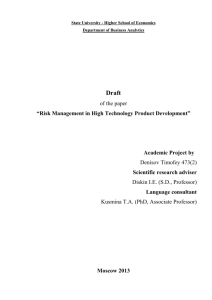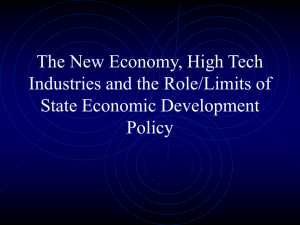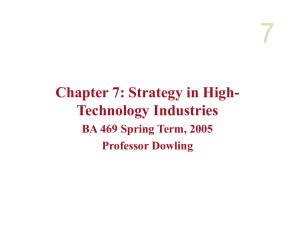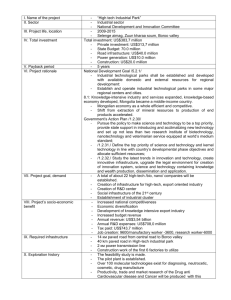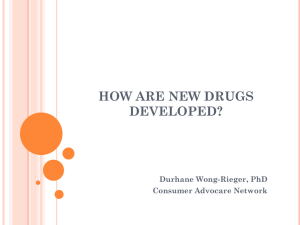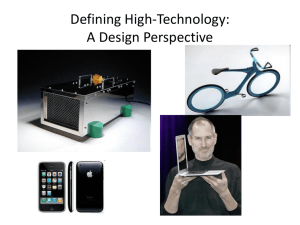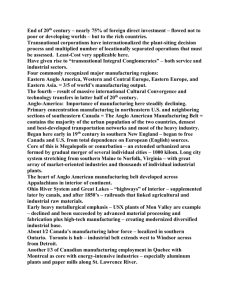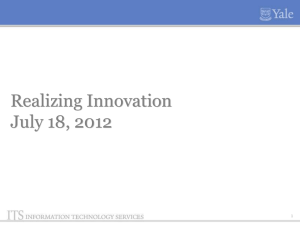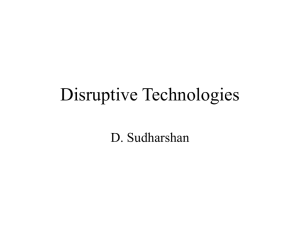High Tech Strategy II
advertisement
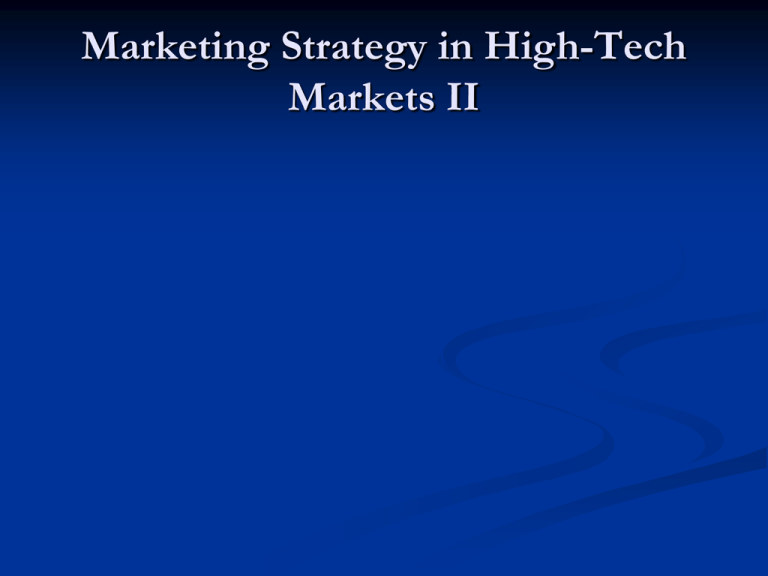
Marketing Strategy in High-Tech Markets II The Big Group Smack Down! Define “High-Tech” and why are hi tech markets particularly dynamic? What do you consider the most important barriers to adoption of the Wearable Computer? Give an example of what you would consider a radical innovation (tech or no tech) and develop a short definition. Contingent on the type of innovation, the role of marketing differs. How? What would you call these and what do they have in common? “Unit-one costs of HT products are often high, payback cycles of a new HT products shorter and shorter.” Why is this so? As a marketing consultant, what do you recommend a company do that has a breakthrough product on its hand ready to launch? Why are High-Tech markets particularly dynamic? No established rules of the game Significant size economies low entry barriers. Back Barriers of Adoption Perceived value Institutional support Observability Compatibility Ease of use Reliability Back Continuum of Innovations Incremental •Extension of existing product or process •Product characteristics well-defined •Competitive advantage on low cost production •Often developed in response to specific market need •"Demand-side" market Radical •New technology creates new market •R&D invention in the lab •Superior functional performance over "old" technology •Specific market opportunity or need of only secondary concern •"Supply-side" market Back Contingency Theory Marketing Strategy New Product Success Type of Innovation -Breakthrough -Incremental Type of marketing strategy is contingent upon the nature of the innovation. Examples of Implications of Contingency Theory: Breakthrough R&D/Marketing Interaction Type of Marketing Research Role of Advertising Pricing Incremental “technology push” “customer pull” Lead users; developers Surveys; focus groups Primary demand; Selective demand; customer education build image May be premium More competitive Back Muskets/then machine guns Steam ships Automobiles PCs Digital photography What is a disruptive technology? Disruptive technologies typically have worse performance, at least in the near term. But: They have features that a few fringe and generally new customers value and which represent a key source of competitive value in the future. Products based on them are typically cheaper, simpler, smaller and frequently more convenient to use - often representing a new product architecture, design, and even market (category). They often bring a new and different value proposition. See Christensen: “The Innovator's Dilemma” Back Characteristics Common to High-Tech Markets: Supply Side “Unit-one” costs: when the cost of producing the first unit is very high relative to the costs of reproduction Ex: development vs. reproduction of software Demand-side increasing returns: When the value of the product increases as more people adopt it Also called network externalities and bandwagon effects Ex: telephone, fax, MS Word Implications: may give away products for free (IM) Characteristics Common to High-Tech Markets: Supply Side Tradeability problems arise because it is difficult to value the know-how which forms the basis of the underlying technology Ex: How much to charge for licensing the rights to a waste-eating microbe? Knowledge spillover: Another type of externality that arises from the fact that technological developments in one domain spur new developments and innovations in other areas. Ex: Human Genome Project Common, Underlying Characteristics of High-Tech Markets: Demand Side Perspective Market Uncertainty Technological Uncertainty Competitive Volatility Market Uncertainty Technological Uncertainty Marketing of High-Technology Products & Innovations Competitive Volatility Market Uncertainty: FUD factor Customer needs Anxiety over the lack of standards and dominant design (Laserdisc, DVD, DivX) Pace of adoption Inability to forecast market size Technology Uncertainty: Will it function as promised? Timetable for new product development? Who will fix customer problems? What are unanticipated/unintended consequences? (When) Will our technology be obsolete? Competitive Uncertainty: Who will be future competitors? What will be “the rules of the game” (i.e., competitive strategies and tactics)? What will “product form” competition be like? competition between product classes vs. between different brands of the same product Implication: Creative destruction? Effects of Uncertainty? Adoption rate! There are five variables that have been cited as responsible for speed of technology adoption: Relative Advantage: the degree to which an innovation is perceived as better than the idea it supersedes Compatibility: the degree to which an innovation is perceived as consistent with existing values, technologies, past experiences, and needs of potential users Complexity: the degree to which an innovation is perceived as relatively difficult to use and understand Trialability: the degree to which an innovation may be experimented with on a limited basis Observability: the degree to which the results of an innovation are visible to others (Wow-factor). Rogers, “Diffusion of Innovation.” Diffusion Rates The printing press (~1440): The automobile (1885): 85 years (full saturation in the 1960s) The fax machine (1843): 75 years (market saturation in US around 1960) The telephone (1876): 400 years (1833, NY Sun). 140 years (late 1980s) The Internet (1968) 35 years Value: Perceived Need-Perceived Price Variables essential to the successful uptake of technology: Providing an infrastructure Providing a function Providing the right price point Providing a compelling need to buy (make it a necessity). Telegraph! Faster than Phone…Why? Morse presented prototype of the electric telegraph to the US Congress in 1838 by 1873 Western Union had carried more than twelve million messages creation of the infrastructure which supported it. cheap and predictable rates. a shared language (global communication). What is a disruptive technology? Muskets/then machine guns Steam ships Automobiles PCs Digital photography What is a disruptive technology? Disruptive technologies typically have worse performance, at least in the near term. But: They have features that a few fringe and generally new customers value and which represent a key source of competitive value in the future. Products based on them are typically cheaper, simpler, smaller and frequently more convenient to use - often representing a new product architecture, design, and even market (category). They often bring a new and different value proposition. See Christensen: “The Innovator's Dilemma” Continuum of Innovations Incremental •Extension of existing product or process •Product characteristics well-defined •Competitive advantage on low cost production •Often developed in response to specific market need •"Demand-side" market Radical •New technology creates new market •R&D invention in the lab •Superior functional performance over "old" technology •Specific market opportunity or need of only secondary concern •"Supply-side" market Supplier vs. Customer Perceptions of Nature of Innovation Mismatch: Delusion Breakthrough Incremental Mismatch: Shadow Contingency Theory Marketing Strategy New Product Success Type of Innovation -Breakthrough -Incremental Type of marketing strategy is contingent upon the nature of the innovation. Examples of Implications of Contingency Theory: Breakthrough R&D/Marketing Interaction Type of Marketing Research Role of Advertising Pricing Incremental “technology push” “customer pull” Lead users; developers Surveys; focus groups Primary demand; Selective demand; customer education build image May be premium More competitive Marketing Strategy in High-Tech Markets II The Big Group Smack Down! Define “High-Tech”. What do you consider the most important barriers to adoption of the Wearable Computer? Give an example of what you would consider a radical innovation and develop a short definition. Contingent on the type of innovation, the role of marketing differs. How? Give an example of what you would consider a disruptive technology and develop a short definition. “Unit-one costs of HT products are often high, payback cycles of a new HT products shorter and shorter.” Why is this so? As a marketing consultant, what do you recommend a company do that has a breakthrough product on its hand ready to launch? Why are High-Tech markets particularly dynamic? No established rules of the game Significant size economies low entry barriers. Continuous shortening of product life cycles, which if true leads to a serious dilemma: => High first part costs in innovation phase is associated with shorter pay-back cycles! Concentrated vs. Differentiated Pros and Cons? Strategic Implications? (Segmentation, timing, participation) STP High innovation costs plus shortening PLC means strategically: 1) 2) Enter as many market segments as possible at the same time to shorten pay-back time. Develop a broad geographical strategy as low entry barriers allow competitors to exploit uncovered territory. STP Three Entry Options: Pioneers Early Followers Late followers What are some pros and cons of each? STP Strategic Considerations: 1) 2) 3) Differentiation versus Standardization? Price-Quantity (cost utility) versus preference oriented (buyer utility)? Customer-orientation versus competitororientation? Back Back
